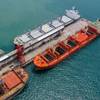Spot LNG Freight Rates Plummets in Q1: Flex LNG
During the first quarter 2019, spot LNG freight rates plummeted from the record levels seen in the previous quarter, said Flex LNG, the company controlled by billionaire John Fredriksen.
Asia winter demand came in lower than expected due to an unseasonably mild weather in northern Asia, coupled with Japanese nuclear power plants restarting as well as an oversupplied LNG market due to start-up of new LNG production, said the emerging player in the LNG shipping.
Asian LNG prices moved lower, trading closer to or at par with key US and European LNG markers, preventing arbitrage opportunities between the markets. Despite significant growth in liquefaction and exported volumes, sailing distances and utilization where challenged by muted trade in the quarter.
Øystein M Kalleklev, CEO said: “First half of 2019 has been challenging due to the disruption in the LNG trade caused by a unseasonably mild winter, a glut of LNG hitting the market as well as shift in trading patterns favouring shorter hauls to Europe."
Global nominal liquefaction capacity reached 393 million tonnes per annum (Mtpa) in the first quarter 2019 according to IGU.
Total trade reached a historic high of 316.5 million tonnes in 2018, of which 31% or 99 million tonnes was classified as Non-long-term trade, illustrating the LNG markets gradual move towards shorter term structures and arbitrage driven moves. Total LNG trade rose by 28.2 million tonnes in 2018, the third largest increase ever.
Preliminary tracking data from KPLER point towards a 15% increase year-on-year for global LNG exports in the first quarter 2019. The combined exports from Australia, Russia and USA reached 32.6 million tonnes, representing a year-on-year growth of close to 30%.
In the same period, the three largest importers Japan, China and South Korea imported 47.25 million tonnes of LNG, representing a slight decline of ~3% compared to first quarter 2018 primarily due to lower heating demand.
According to industry sources, 12 LNG carriers and one FSRU were delivered in the first quarter of 2019. 13 new LNG orders were reported in the same period. By the end of the quarter, there were 471 vessels above 125,000 cbm in the global LNG fleet, excluding FSRU’s.
The order book at the end of the quarter amounted to 107 conventional vessels, of which 44 were reported as ‘uncommitted’. 23 conventional LNG carriers are scheduled for delivery in 2019, 37 in 2020, 39 in 2021 and 8 in 2022.
The global liquefied natural gas market is expected to grow substantially in the coming years. Total proposed liquefaction capacity is at 843 Mtpa, more than double existing facilities. Over the next two years about 60 Mtpa of liquefaction is expected to come on-line. In the same period, 2019/20, about 120 Mtpa of additional liquefaction capacity is expected to reach final investment decision with the majority in Canada and USA.
Demand is expected to grow firmly as China in particular continues to focus on energy efficiency and improvements in air quality in key metropolitan areas. Economic policies in the country are to an increasing degree focused on environmental advances rather than pure economical growth.
Chinese LNG imports grew 41% in 2018 to ~53 Mtpa. US LNG tariffs have so far primarily affected the Chinese sourcing of LNG, not the country’s growing import volumes, up 28% compared to the first quarter 2018.
Outlook for LNG shipping demand, albeit showing slow growth in the first quarter 2019, remains sound due to new liquefaction capacity coming on-line in the western hemisphere, coupled with robust demand growth in the eastern parts of the world.
Traditionally market analysts have estimated shipping demand to increase by 1.3 LNG carriers per new million ton of liquefaction capacity per annum. Recent liquefaction growth in USA and Russia yield a higher multiple as the distance from supply to key markets are considerable longer implying tonne miles growth.













